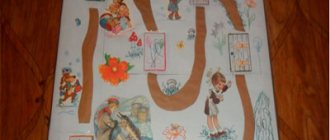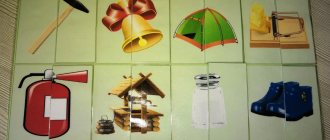The second training period is December, January, February.
The content of correctional education includes:
- Development of general speech skills.
- Continue to work on developing proper speech breathing in children.
- To improve children's ability to voluntarily change the strength, pitch and timbre of their voice.
- Improve your voice skills with a soft attack, at a calm pace.
- Continue to work on clarity of diction and intonation expressiveness of speech.
- Build expressive reading skills, develop correctness, fluency and awareness (based on short poems chosen by a speech therapist)
- Articulation gymnastics.
- Introduce interactive articulation gymnastics-fairy tale.
- Prepare the organs of the articulatory apparatus for the correct pronunciation of sounds.
- Develop facial muscles.
- Sound pronunciation.
- Continue to work on automating the correct pronunciation of assigned sounds in children.
- To form the correct pronunciation of sounds in newly admitted children.
- Work on the syllabic structure of the word.
- Pronounce words of an accessible speech class.
- Gradually increase the complexity of classes.
- Development of phonemic representations.
- Strengthen in children the ability to select words for a given sound.
- Exercise children in distinguishing between hard and soft consonants in a series of sounds, syllables, and words.
- Improve the skill of isolating a given sound from a word.
- Strengthen the ability to conduct sound analysis and synthesis of words such as dad, table, bush, linden, leaf, cry.
- Learn to analyze and synthesize words of 5 sounds.
- Introduce children to new sounds. Exercise children in isolating these sounds from words, in selecting words with these sounds.
- Improve the skill of sound analysis of words and analysis of sentences without prepositions and with simple prepositions. Exercise children in drawing up graphic diagrams of sentences.
- Certificate.
- Improve children's typing and reading skills of syllables and words with mastered letters.
- Introduce children to new letters.
- Exercise children in laying out new letters from sticks, in typing, and “drawing” in the air.
- Continue teaching children how to solve puzzles and crossword puzzles.
- Improve the ability to transform letters, distinguish between correctly and incorrectly printed letters, complete unfinished letters, read letters superimposed on each other.
- Strengthen the ability to correctly name the letters of the Russian alphabet.
- Teach children to print and read syllables, words, sentences with new letters.
- Vocabulary.
Lexical topics.
| December | Week 1 – “Wintering Birds”. Week 2 – “Pets”. Week 3 – “Domestic animals and birds and their young.” Week 4 – “Winter. Winter fun. New Year". |
| January | Week 2 – “Winter. Winter clothes". Week 3 – “Man. Body parts". Week 4 – “Transport. Traffic Laws". |
| February | Week 1 – “Materials and Tools”. Week 2 – “Professions. Construction". Week 3 – “Defenders of the Fatherland.” Week 4 – “Seasons. Calendar. Spring". |
- Systematize children's knowledge about winter, about winter natural phenomena. Introduce children to the winter months. To consolidate children's knowledge about wintering birds. Expand your understanding of the behavior and habits of the crow, tit, bullfinch, and waxwing. Explain why birds need to be fed in winter. Expand your understanding of the life of wild animals in winter.
- Clarify concepts, expand ideas about materials and tools.
- Strengthen children's ideas about the New Year holiday. Reinforce the knowledge that there are 12 months in a year, that the year begins on January 1. Give an idea of how the New Year is celebrated in different countries.
- Systematize children's ideas about the diversity of wintering birds.
- Systematize children’s ideas about transport, form an idea about types of transport, about professions in transport.
- To consolidate and expand children's knowledge about professions, the content of work, and the role of labor mechanization. Foster respect for working people and the need to work.
- To consolidate and expand children's knowledge about the tools used by representatives of various professions and the actions performed with the help of these tools.
- Systematize children's ideas about the habitats of domestic animals and wild animals. Expand and deepen your understanding of preparing them for winter. To achieve children's understanding of the role of humans in keeping pets.
- Enter nouns, adjectives and verbs on these lexical topics into the active dictionary.
- Explain the figurative meaning of set expressions; explain the meaning of words based on their word-formation structure, activate word-formation processes.
- Development of grammatical structure of speech.
- To improve children’s ability to form and use singular and plural nouns in speech (on the topics: “Human. Parts of the body”, “Transport”, “Professions. Construction”, “Defenders of the Fatherland”, “Seasons. Calendar. Spring”.
- Introduce children to methods of word formation (on the topic: “Materials and tools”).
- Continue work on teaching the agreement of adjectives with nouns (on all lexical topics).
- Teach the correct use of relative and possessive adjectives in speech (on lexical topics: “Pets”, “Pets and birds and their young”, “Wintering birds”, “Winter. Winter clothing”, “Human. Parts of the body”).
- To consolidate the ability to correctly use simple and complex prepositions in speech (on the topics: “Pets”, “Winter. Winter clothes”).
- Continue to work on learning to form and use verbs with various prefixes in speech; verbs denoting labor actions (for all topics).
- Work on correcting agrammatisms in children’s speech.
- Teaching coherent speech.
- Improve the ability to compose stories about a subject on worked topics using a collectively drawn up plan (by picture, by pictures, by a series of pictures).
- Teach children to write stories based on personal experience, to talk about experiences related to what they read and saw.
- Teach children to understand and interpret words, compare, explain proverbs and riddles.
- Work on improving the processes of attention, memory, operations of analysis, synthesis, comparison, generalization and classification.
X. Development of spatial, temporal and elementary mathematical concepts.
- Teach children to reflect the spatial position of objects in speech. Strengthen the ability to express spatial relationships with complex prepositions because of, from under, etc.
- Teach children to navigate on a sheet of squared paper, use adjectives to the left, to the right, above, below.
- Reinforce the idea of the sequence of days of the week and months of the year. Fix the names of the days of the week and months of the year in speech. Learn to establish age differences between people.
- Fix in speech the words wider, narrower, higher, lower, more, less, longer, shorter.
- Exercise children in the use of various prepositional-case constructions.
- Teach children to accurately select verbs of motion with prefixes of spatial meaning (drove in, left, moved, drove off, left).



